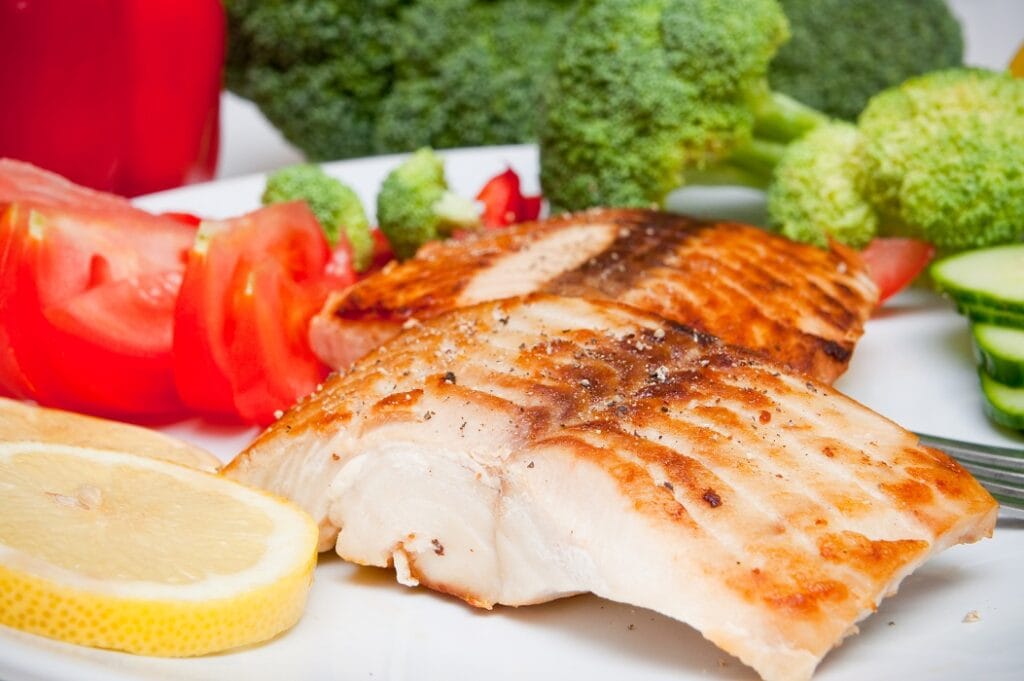If you’re looking for a diet that combines the benefits of a ketogenic diet with the flexibility of a pescatarian lifestyle, the pescatarian keto diet might be for you! It merges the best aspects of these two popular eating styles: the high-fat, low-carb focus of keto with the plant-based, seafood-centric pescatarian diet.
In this guide, we’ll explore everything you need to know about the pescatarian keto diet: how it works, what foods you can eat, some tasty pescatarian keto recipes, and a handy keto pescatarian food list to get you started.
1. What is the Pescatarian Keto Diet?
The pescatarian keto diet is a unique way of eating that combines elements from both the ketogenic and pescatarian diets. Here’s a breakdown of each:
- Keto Diet: The ketogenic diet is a low-carb, high-fat diet that encourages the body to use fat instead of carbohydrates for energy. By reducing carbs and increasing fats, the body enters a state called ketosis, where it burns fat for fuel.
- Pescatarian Diet: A pescatarian diet is primarily plant-based but includes fish and seafood as the main source of protein, avoiding meat from land animals. Many people choose this diet for environmental or ethical reasons, as well as for its health benefits.
The pescatarian keto diet combines these two approaches. You’ll eat low-carb, high-fat meals focused on fish, seafood, healthy fats, and vegetables. It can be a fantastic choice for anyone looking to get the benefits of ketosis while still enjoying the nutrient-rich profile of seafood.
2. Benefits of a Pescatarian Keto Diet
2.1. Heart Health
Both keto and pescatarian diets are known for potential heart-health benefits. Fatty fish like salmon and sardines are rich in omega-3 fatty acids, which help reduce inflammation and support heart health.
2.2. Nutrient-Dense and Low-Carb
Seafood, especially fatty fish, is packed with essential vitamins and minerals like Vitamin D, B12, and iodine. These nutrients can sometimes be challenging to get on a regular keto diet, especially one that limits dairy and some vegetables.
2.3. Weight Loss
Many people report weight loss when switching to a pescatarian keto diet, as the diet encourages low-carb eating, which reduces hunger and helps the body burn stored fat.
3. Foods You Can Eat on a Pescatarian Keto Diet
Choosing the right foods is essential to stay within the keto guidelines while focusing on seafood-based meals. Here’s a breakdown of foods that work well in a pescatarian keto diet:
3.1. Fish and Seafood
- Salmon: Rich in omega-3 fats, it’s perfect for keto.
- Tuna: High-protein and low-carb.
- Shrimp: A versatile, low-carb seafood option.
- Mackerel: Packed with healthy fats.
3.2. Healthy Fats
To reach your daily fat intake, include:
- Avocado: High in fiber and healthy fats.
- Olive Oil: Great for cooking and salad dressings.
- Coconut Oil: Adds flavor and helps with ketosis.
3.3. Low-Carb Vegetables
- Leafy Greens: Spinach, kale, and arugula are ideal.
- Broccoli: Low-carb and high in nutrients.
- Zucchini: Excellent for keto-friendly noodles and sides.
4. Top Pescatarian Keto Recipes
Experimenting with new recipes can keep your pescatarian keto meals exciting and delicious. Here are some easy ideas to try:
4.1. Keto Avocado Shrimp Salad
Ingredients: Shrimp, avocado, cucumber, olive oil, lemon, and spices.
Instructions: Cook shrimp and let them cool. Dice avocado and cucumber, then mix everything with olive oil, lemon juice, and seasoning.
4.2. Baked Salmon with Asparagus
Ingredients: Salmon fillets, asparagus, garlic, and butter.
Instructions: Place salmon and asparagus on a baking sheet, drizzle with melted butter and garlic, and bake at 400°F until salmon is flaky.
5. Keto Pescatarian Food List
Creating a go-to list of foods is essential for staying on track. Here’s a keto pescatarian food list to help you plan meals and shop for ingredients:
Protein Sources
- Salmon
- Sardines
- Scallops
- Cod
Fats and Oils
- Avocado Oil
- Butter (grass-fed)
- Coconut Oil
Vegetables
- Bell Peppers
- Cauliflower
- Eggplant
6. How to Get Started on a Pescatarian Keto Diet
Starting any new diet can feel overwhelming, so here are a few steps to make it easier:
- Plan Your Meals: Use the food list above to create weekly meal plans.
- Stock Your Pantry: Keep essentials like canned fish, olive oil, and low-carb vegetables on hand.
- Track Your Carbs: Use a food-tracking app to stay within your daily carb limit.
Absolutely! Adding a section on benefits and tips for optimizing the pescatarian keto diet will provide a well-rounded understanding for readers. Here’s how you can structure that section:
7. Benefits of the Pescatarian Keto Diet
The pescatarian keto diet combines the best of two dietary worlds, delivering a range of health benefits that include improved heart health, weight management, reduced inflammation, and more. Here’s a closer look at the specific benefits:
1. Improved Heart Health
Fish, particularly fatty fish like salmon, mackerel, and sardines, are packed with omega-3 fatty acids. These fats are known to reduce inflammation, lower blood pressure, and decrease the risk of heart disease. By focusing on seafood and healthy fats, the pescatarian keto diet can help support your heart’s health better than standard keto alone, which often relies on saturated fats from meat and dairy.
2. Enhanced Brain Health and Cognitive Function
Omega-3s aren’t only good for your heart—they’re also great for your brain. DHA (docosahexaenoic acid), a specific type of omega-3, is essential for brain health. The pescatarian keto diet offers plenty of DHA from seafood sources, which can support memory, focus, and overall cognitive health.
3. Weight Management and Fat Loss
The pescatarian keto diet is naturally low-carb and high-fat, which encourages the body to burn fat for fuel, leading to weight loss. Studies have shown that low-carb diets can suppress hunger and stabilize blood sugar, making it easier to maintain a calorie deficit and lose weight over time.
4. Reduced Inflammation
Chronic inflammation is associated with various health problems, including heart disease, arthritis, and autoimmune disorders. The omega-3 fatty acids in fish are known for their anti-inflammatory properties, making this diet particularly beneficial for anyone looking to reduce inflammation while still enjoying a low-carb, high-fat lifestyle.
5. Better Gut Health
Many of the vegetables encouraged on a pescatarian keto diet, such as leafy greens, broccoli, and zucchini, are rich in fiber. Fiber plays an important role in gut health by promoting healthy digestion and supporting a diverse microbiome. Additionally, seafood offers easier-to-digest proteins compared to red meats, which can be gentler on the digestive system.
6. Higher Nutrient Density
Seafood is rich in essential nutrients such as vitamins B12, D, and iodine. These nutrients are often harder to obtain on a standard keto diet, especially if dairy is limited. The pescatarian keto diet also allows for a wider range of nutrient-dense vegetables, which means you’re more likely to meet your nutritional needs while staying in ketosis.
8. Tips to Get the Most Out of the Pescatarian Keto Diet
Making the pescatarian keto diet work for you involves smart planning and awareness of key nutrients. Here are some tips to help you maximize the benefits:
1. Focus on Quality Fish and Seafood
Opt for wild-caught fish when possible, as it tends to have higher levels of omega-3 fatty acids and fewer contaminants than farm-raised options. If you’re on a budget, you can still find quality options like canned wild salmon, sardines, and mackerel, which are affordable and nutrient-rich.
2. Include a Variety of Fats
While seafood provides healthy fats, you’ll also want to incorporate other keto-friendly fats to stay satisfied and in ketosis. Avocado, olive oil, coconut oil, nuts, and seeds are excellent sources that can add variety to your meals. Additionally, MCT oil can be a great addition for those wanting an extra boost in ketosis.
3. Prioritize Low-Carb, High-Fiber Vegetables
Include a wide range of low-carb vegetables to get fiber and essential nutrients. Leafy greens, cruciferous vegetables (like broccoli and cauliflower), and avocados are all excellent choices. Fiber not only aids digestion but can also support stable blood sugar levels, helping you avoid energy crashes.
4. Track Your Macronutrients
Keeping track of your daily carb intake is important to stay in ketosis. Use a food-tracking app to ensure you’re meeting your macros, especially if you’re new to keto. Many beginners find it helpful to start with 20-30 grams of net carbs per day and adjust based on how they feel and their progress.
5. Plan and Prep Your Meals
To avoid the temptation of carb-laden foods, prep your meals in advance. Having a meal plan and ready-to-go snacks makes it easier to stick to the diet. Prep seafood salads, keto-friendly dips, and vegetable-based side dishes for quick meals and snacks throughout the week.
6. Consider Supplementing with Essential Nutrients
While the pescatarian keto diet is nutrient-rich, some people may still find it beneficial to take supplements for nutrients that may be lower in the diet. Consider B12, iodine, magnesium, and vitamin D supplements, especially if you limit dairy. Consult with a healthcare provider to see what supplements may be right for you.
7. Experiment with Flavors and Recipes
Avoid falling into a flavor rut by experimenting with new recipes and spices. Seafood pairs well with many herbs and spices, such as garlic, basil, dill, lemon, and rosemary. Try different methods of cooking (e.g., baking, grilling, pan-searing) to keep things interesting.
8. Stay Hydrated and Mind Electrolytes
A keto diet can initially lead to fluid loss as glycogen stores are depleted, making hydration crucial. Be sure to drink plenty of water, and consider adding electrolytes like sodium, potassium, and magnesium to prevent symptoms of the “keto flu.” Coconut water (in moderation), spinach, and avocado are all great sources of electrolytes.
9. Listen to Your Body
Everyone’s body responds differently to dietary changes, so listen to yours. Some may need slightly more carbs from vegetables to feel their best, while others thrive on a stricter low-carb intake. If you feel fatigued, light-headed, or unwell, assess your macronutrient balance and hydration, and make adjustments as needed.
9. Sample Daily Meal Plan for the Pescatarian Keto Diet
To help you get started, here’s a sample daily meal plan that includes tasty pescatarian keto recipes:
Breakfast
- Avocado Salmon Bowl: Mix diced avocado, smoked salmon, cucumber, and a sprinkle of sesame seeds with a dash of olive oil.
Lunch
- Keto Shrimp Salad: Combine cooked shrimp with mixed greens, cherry tomatoes, cucumbers, and a dressing made from olive oil, lemon, and dill.
Snack
- Olives and Cheese Plate: A small portion of olives with feta cheese, drizzled with olive oil.
Dinner
- Baked Cod with Cauliflower Mash: Oven-baked cod with a side of creamy cauliflower mash (made with butter and garlic).
Dessert (Optional)
- Coconut Fat Bombs: Mix coconut oil, shredded coconut, and a small amount of stevia, then freeze into small bites for a keto-friendly treat.
By following these tips and taking a balanced approach, the pescatarian keto diet can provide a range of benefits that support weight loss, heart health, and general well-being. Plus, with plenty of tasty seafood and fresh produce, you’ll enjoy a flavorful, nutritious, and satisfying diet that’s sustainable for the long term!
Frequently Asked Questions
Can I have dairy on a pescatarian keto diet?
Yes, dairy can be part of a pescatarian keto diet, but it’s essential to focus on full-fat, low-carb options like cheese and cream.
What are some easy pescatarian keto snacks?
Some great options include:
- Cucumber slices with smoked salmon
- A handful of olives
- Celery with almond butter
Is a pescatarian keto diet sustainable?
For many people, yes. This diet provides variety, nutrient-dense foods, and flexibility, making it easier to stick with long-term compared to strict keto or pescatarian alone.
The pescatarian keto diet can be a fantastic approach for those seeking a balanced, heart-healthy, and low-carb way of eating. By combining the low-carb benefits of keto with the seafood richness of a pescatarian diet, you can create meals that are both nutritious and satisfying. With a little planning and creativity in the kitchen, you’ll find plenty of delicious options that support your goals.


